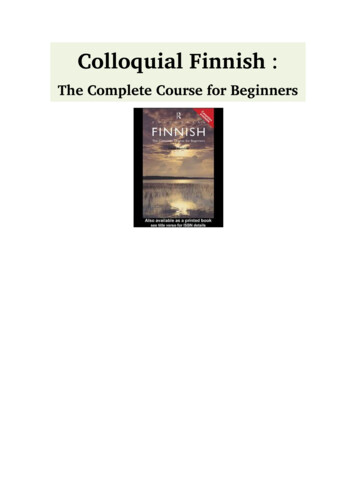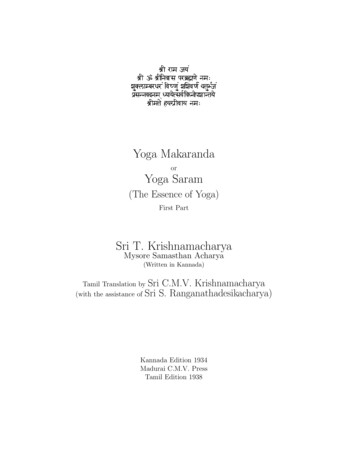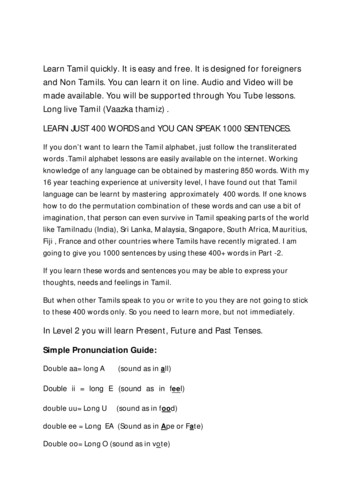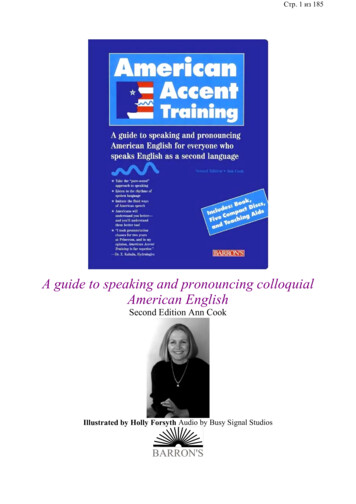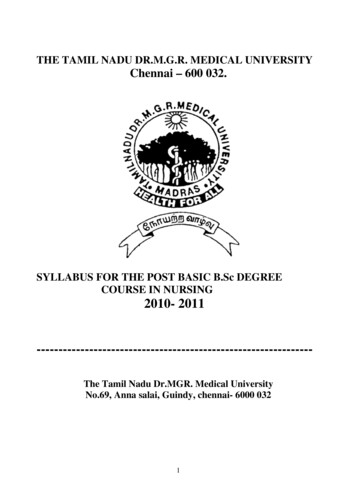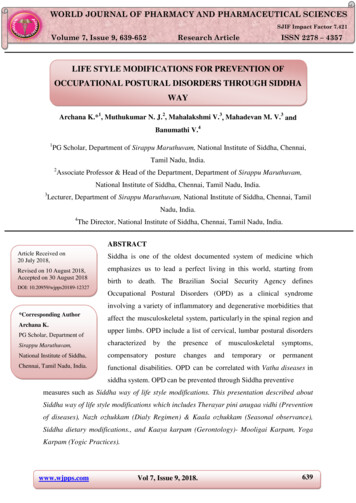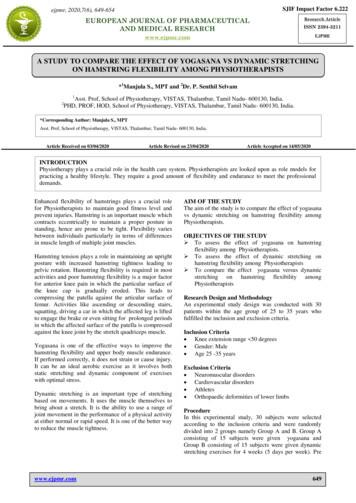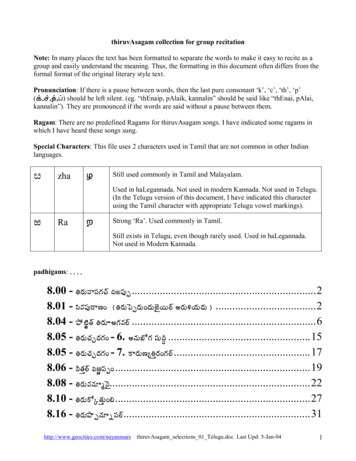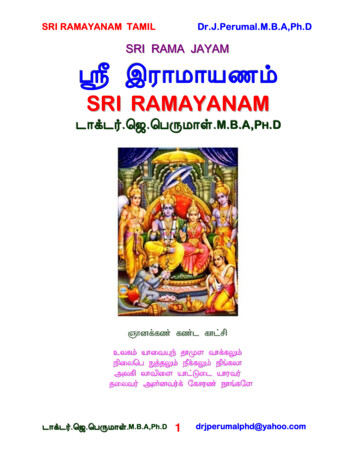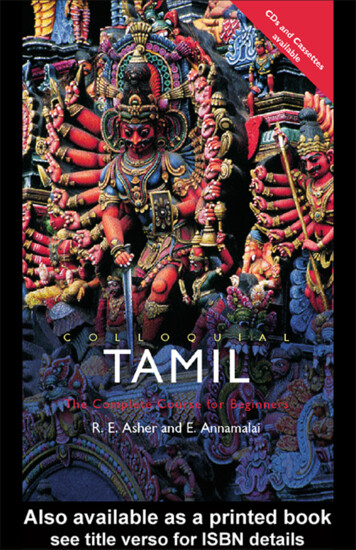
Transcription
252627282930313233343536373839404142Tamil
930313233343536373839404142The Colloquial SeriesSeries Adviser: Gary KingThe following languages are available in the Colloquial series:AfrikaansAlbanianAmharicArabic (Levantine)Arabic of EgyptArabic of the Gulf andSaudi ArabiaBasqueBulgarian* Cambodian* Cantonese* ChineseCroatian and e of BrazilRomanianRussianScottish GaelicSlovakSloveneSomaliSpanishSpanish of Latin eseWelshAccompanying cassette(s) (*and CDs) are available for the abovetitles. They can be ordered through your bookseller, or sendpayment with order to Taylor & Francis/Routledge Ltd, ITPS,Cheriton House, North Way, Andover, Hants SP10 5BE, UK, or toRoutledge Inc, 29 West 35th Street, New York NY 10001, USA.COLLOQUIAL CD-ROMsMultimedia Language CoursesAvailable in: Chinese, French, Portuguese and Spanish
iii12345678910111213141516171819202122 R.E. Asher and E.23242526272829303132333435LE36UT D373839orr40& F r n cis Ga4142 London and New YorkColloquialTamilpyTalou GEROThe Complete Coursefor BeginnersAnnamalai
iv123456789101112131415161718First published 2002by Routledge11 New Fetter Lane, London EC4P 4EESimultaneously published in the USA and Canadaby Routledge29 West 35th Street, New York, NY 10001Routledge is an imprint of the Taylor & Francis GroupThis edition published in the Taylor & Francis e-Library, 2005.“To purchase your own copy of this or any of Taylor & Francis or Routledge’scollection of thousands of eBooks please go to www.eBookstore.tandf.co.uk.” 2002 R. E. Asher and E. ll rights reserved. No part of this book may be reprinted orreproduced or utilised in any form or by any electronic,mechanical, or other means, now known or hereafter invented,including photocopying and recording, or in any informationstorage or retrieval system, without permission in writing fromthe publishers.British Library Cataloguing in Publication DataA catalogue record for this book is available fromthe British LibraryLibrary of Congress Cataloging in Publication DataTO FOLLOWISBN 0-203-99424-8 Master e-book k)(tape)(CD)(pack)
vContents12345678910 Introduction111213 1 en peeru MuruganMy name is Murugan141516 2 naan viiTTukku pooreenI’m going home17183 enna vee um?19What would you like?2021 4 haloo, naan Smith peesureen22Hello, this is Smith2324 5 mannikka um, taamadamaa25varradukku26I am sorry that I am late.27(Lit: Excuse me for coming late)2829 6 Mahaabalipuram poovamaa?Shall we go to Mahabalipuram?303132 7 niinga enge pooriinga?Where are you going?3334 8 niinga eppa Indiyaavukku vandiinga?35When did you come to India?3637 9 niinga pooTTurukkira ras38The clothes you are wearing3940 10 neettu oru kalyaa attukku pooyirundeenYesterday I went to a wedding414292539526685100117133145
93031323334353637383940414211 nii enne paakka varakkuu aadaa156Shouldn’t you come to see me?2 e2 uuru YaaΩppaa am12 end166I’m from Jaffna13 inda e attukku ep i pooradu?177How do I get to this place?14 enna sirikkiree?190What are you laughing at?15 naan TamiΩnaaTTule re u naaÒdaanirukka mu iyum200I can be in Tamil Nadu for just a couple of days16 TamiΩle oru siranda nuulu216A famous book in TamilThe Tamil alphabetGrammatical summaryKey to exercisesTamil–English glossaryEnglish–Tamil glossaryIndex of grammatical terms225227236275295312
vii12345ANDHRA6PRADESHKARNATAKA7BangaloreChennai TAMILKumbakonamTrichy17NADUThanjavur18 KERALA1920Madurai21Jaffna2223242526Trincomalee27 Trivandrum2829Kanya KumariBatticaloa(Cape Comorim)30313233Colombo343536373839404142
0313233343536373839404142
293031323334353637383940414211IntroductionWhere Tamil is spokenThe number of speakers of Tamil worldwide is in excess of 65million. The two principal homelands of the language are India,where it is the mother tongue of 87 per cent of the population ofthe state of Tamil Nadu in the south-east of the country, and SriLanka, where a quarter of the inhabitants are Tamil speakers. Inthe northern and eastern provinces of Sri Lanka, Tamil speakersare in the majority. During the nineteenth and twentieth centuries,considerable numbers of Tamilians migrated from both India andSri Lanka to other countries. These countries include Malaysia,Singapore, Mauritius, Fiji, South Africa, the United Kingdom,Germany, the United States, and Canada.The history of the languageTamil has a very long recorded history. Inscriptions in the languagedate back to the middle of the third century BC, and the earliestTamil poetry – some of the finest poetry ever written – is thoughtto have been produced not less than two millennia ago. Goodmodern translations of the lyrical and bardic poetry of this so-calledSangam age are available in English.The hundreds of languages spoken in India belong to fourdistinct language families, of which the two with the largestnumbers of speakers are Indo-Aryan and Dravidian. The formerare related to the languages of western Europe as members of thelarger Indo-European family. The thirty or more Dravidianlanguages of which Tamil is one are not so related. There has,however, been mutual influence, particularly through the borrowingof words. Modern Tamil, especially the spoken variety, also makesuse of a number of English words, as you will see as you progressthrough this book.
2Enjoying Tamil cultureTamil has a very rich culture, and a visit to Tamil Nadu is particularly rewarding from this point of view alone. One of the dialoguesin this volume relates to the renowned rock sculptures and monolithic temples near the shore of the Bay of Bengal at Mahabalipuram – carved in the seventh century. Somewhat later comesthe magnificent Dravidian style architecture of the great temples,with their towering gopurams, that are to be found in ancientcities throughout the state. The history of Tamil sculpture is a studyin itself. Stone is the more commonly used medium, but bronzetoo has been used over a long period, notably for sculpturesof Siva as Nataraja, Lord of the Dance. One famous temple, atChidambaram, has carvings of poses in the unique Tamil classicaldance form – bharatha natyam. Dance recitals in this style are giventhroughout the year, but the most opportune time to see them isin December in Chennai (Madras), where each year there is a greatfestival of dance and of classical music, both vocal and instrumental.There is a thriving film industry too, and the production of filmsin Tamil is second in India only to that of Hindi films.Quite a different aspect of life in Tamil Nadu relates to the factthe state is in the forefront of information technology. Coincidingwith the dawn of a new millennium is the creation of a new sciencecity at Taramani in Chennai.Colloquial and written TamilThe language of writing differs considerably from the language ofeveryday conversation – so much so that there is no universallyaccepted way of writing the colloquial variety in Tamil script. Thisbook concentrates on the colloquial language, but devotes a modestamount of space to introducing the written language, on theassumption that learners will want at the very least to deciphersigns they might see in travelling in Tamil-speaking parts of theworld. What we are calling written language is also the languageof formal speech – as in platform speaking, lecturing, reading newsbulletins on the radio or television, and so on. A knowledge of thisformal style is inadequate for anyone who wishes to converse,whether it is to ask the way or to buy a train ticket, a meal, or apostage stamp. Formal speech and writing on the one hand andcolloquial speech on the other differ from each other in a number
8293031323334353637383940414211of ways, for instance, in the important grammatical endings thatare added to nouns and verbs and also in the choice of words. Youwill see something of the nature of these differences in Lesson 16.Varieties of colloquial TamilNo language is without its dialects, and colloquial Tamil varies fromregion to region and from social group to social group. However,partly through the influence of films and popular radio and television programmes, something approaching a standard variety hasevolved in South India. This, being the one most widely used andunderstood, is the variety introduced in this book.Language and societyCultural differences often show up in the impossibility of transferring conventional items of conversation from one languagecommunity to another. In the dialogues presented in this book,therefore, you should not expect to find in all situations exact translation equivalents of common English social interchange. Englishoften expresses politeness by such words as ‘please’ or ‘thank you’.In Tamil, such lubrication of vocal interaction is done by tone ofvoice, facial expression, and sometimes by grammatical features.One effect of this sort of thing is that a Tamil dialogue that istotally natural and authentic may have features that seem slightlystrange in an English translation the aim of which is to assist inthe understanding of what is there in Tamil. You should try to getthe feel of this aspect of the language just as much as the basicgrammatical structures.PronunciationTo understand spoken Tamil and to speak it intelligibly, it is necessary to become familiar with a number of sounds that are not foundin English. Points of pronunciation that a learner needs to be awareof are explained in this section in terms of the Roman transcription used in the sixteen lessons of this book. The letters used,including some that are not part of the Roman alphabet as usedfor English, are: a, aa, i, ii, u, uu, e, ee, o, oo; k, g, c, j, †, , t, d,p, b, , n, m, y, v, r, l, , Ω, j, s, ß, h.
4You will notice that the vowels listed come in pairs of one long(these are indicated by double letters) and one short. This distinction is very important, as it is the only difference in quite a largenumber of pairs of words. Just as it is necessary to distinguish inEnglish between such words as ‘beat’ and ‘bit’, so such words aspaattu ‘having seen’ and pattu ‘ten’ must be kept apart in Tamil.We give below examples of the ten vowels, providing hints as tothe pronunciation with English words. It is important to remember,however, that these are only approximations, above all becauselong vowels in English are in many cases phonetically diphthongs– that is to say that the nature of the sound is not constantthroughout – as contrasted with pure vowels. In this sense, thevowels of Tamil are more akin to, say, the vowels of French orItalian, or to the vowels of northern (British) English or Scots. Itis important, therefore, that you listen to how native speakerspronounce words, either in person or by using the recordings thataccompany this book. uveleveeleoruoo sasasasasasinininininininininincat (northern English)part (southern English)pinkeenputcoolbellvainoliveownOne sort of vowel used in colloquial Tamil (though not in formalTamil) that is not found in English is nasal vowels. These occuronly in the final syllable of words and are indicated in the transcription by a vowel followed by m or n. Similar vowels are foundin French. You will be readily understood if you pronounce theconsonant, but you should try to copy the nasal vowels. The twosequences -am and -oom are very similar, being distinguished, ifat all, only by the slightly greater length of the second. The sameis true of the pair -an and -een. For the benefit of those who arefamiliar with them, standard phonetic symbols are given in squarebrackets. Examples:
ay come‘he came’‘tree’‘we came’‘he’‘I came’‘it will ][ɔ̃][ɔ̃][ẽ][ẽ][ũ]For many speakers, the last sound, [ũ], has merged with [ɑ̃], so thatthe last syllables of maram and varum have the same sound. If,because something is added to the word, the m or n in these wordsno longer comes at the end, you should pronounce it as a consonant. For example, -aa can be added to the last word of a sentenceto turn a statement into a question. So, while vandaan means ‘hecame’, vandaanaa means ‘did he come?’Careful listeners will notice subtle differences between theconsonants of Tamil and those of English that are written with theRoman symbols we are using for Tamil. We concentrate here onfeatures of pronunciation that are vital for clear understanding.In accordance with conventions for transcribing words from Indianlanguages into Roman, c is used for a sound similar to that represented by ‘ch’ in English ‘church’. This sound often alternates withs at the beginning of a word.It is important not to pronounce the letters t and d as in English.Used for Tamil, these letters represent dental sounds (as in French).When you articulate them, make sure that the tip of your tonguetouches the upper front teeth. This is important in order that theseshall be clearly distinct from the sounds † and which are discussedin the next paragraph but one.Careful listening will show that d has a different pronunciationdepending on what other sounds come next to it. At the beginningof a word, and after n in the middle of a word, it has the soundof a French d, as just mentioned. When it occurs between vowelsin the middle of a word, however, it sounds more like the ‘th’ inEnglish ‘other’. The case of g is somewhat similar to this. At thebeginning of a word (where it occurs only rarely), and after n inthe middle of a word, it has the sound of English ‘g’. When itoccurs between vowels in the middle of a word, however, it mayhave the sound of English ‘h’ or the sound of ‘ch’ in the Scottishpronunciation of ‘loch’. Examples of these are:
6denamandaaduviidiGaandiangemaganmagiΩcciday, dailythat (adjective)it(broad) streetGandhitheresonhappinessOne set of sounds needs special mention. These sounds are oftenlabelled ‘retroflex’, because the tip of the tongue is turned backwards when they are pronounced. It is thus the underside of thetongue that approaches or touches the roof of the mouth. All thesesounds are represented here by special Roman letters which sharethe feature of ending in a tail that turns upwards. This should remindyou of what to do with your tongue! Listen very carefully to wordson the tape containing these sounds. Except in some words borrowed from another language (as shown in the first word listed),these sounds do not occur at the beginning of a word. You may wellnotice that the preceding vowel has a special quality too. This willhelp you to distinguish the consonants. Here are a few examples:†iipaa††upaa upa ampaΩampu ika߆amteasongsingmoneyfruit, bananatamarindtrouble, difficultyYou will observe frequent occurrences of a sequence of twoidentical consonant letters. It is important to remember that thisindicates that the consonant sound in question is noticeably longerthan for a single letter. If you think about how the spelling systemworks, you will realise that this is quite unlike what happens inEnglish: the ‘m’ sound of ‘hammer’ is no longer than that of‘farmer’. With this, compare the pairs of Tamil words in the listbelow (where the consonants illustrated are those where thedistinction between long and short is most important). To get asimilar ‘long’ consonant in English, one has to think of instanceswhere, for example, an ‘m’ at the end of one word is followed byan ‘m’ at the beginning of another. Try saying these two sentences,
8293031323334353637383940414211and see if you can feel and hear a difference: ‘Tom makes all sortsof things; Tom aches all over’.pa ammanamaamaakalepu ivarapayanmoneymemoryyesarttamarindto comeusefulnesspa ukannamammaakallupu ivarraapayyanmakecheekmotherstonedotshe is comingboyThis difference between single and double consonants is particularly important for those in the above table ( / , n/nn, m/mm, l/ll, / , r/rr and y/yy). It is less significant for such pairs as k/kk, t/tt,and p/pp.Finally, you should take some care with what are called intonation and stress patterns. Intonation has to do with the way the pitchof the voice goes up and down in speech. You will observe thatthe pattern of this rise and fall is not the same for Tamil andEnglish. As far as stress is concerned, the contrast between weaklyand strongly stressed syllables is much greater in English than inTamil. You will find it helpful in listening to the tapes to observeall such points and then try to imitate as closely as possible whatyou hear.Writing systemThe Tamil writing system is introduced in stages through a shortsection on the script at the end of each of the first eleven lessons.The principal purpose of this is to put the reader in the positionof being able to read the various signs to be seen in a Tamilspeaking town. The presentation of the writing system is done insuch a way as to allow those who wish to do so to concentratesolely on the spoken language in the early stages of their study ofTamil.The script is unique to Tamil. It is sometimes described assyllabic. The reason for this will soon become apparent: a sequence(in sound) of consonant vowel has to be read as a single unit,since the sign indicating the vowel may come before the consonantletter (as well as after, above, underneath, and part before and partafter). The system shares something with an alphabet, however, in
8that in a given complex symbol it is usually possible to see whichparts represent the consonant and which the vowel. In this respectit is not a ‘true’ syllabary (as compared, for instance, with the hiragana and katakana syllabaries of Japanese). It has therefore beenclassified, along with most of the writing systems used for thelanguages of South Asia and many of Southeast Asia, as an ‘alphasyllabary’. An appendix at the end provides a chart of the simpleand combined symbols.Tamil grammarTo any one with a knowledge of only western European grammar,the grammar of Tamil provides a number of surprises. We look atjust two of these here. First, the basic order of words in a sentenceis different, in that most usually the last word in a Tamil sentenceis a verb; corresponding to English ‘Tom saw her’, Tamil, one mightsay, has ‘Tom her saw’. After a little exposure to the language youwill soon get used to this. The second major characteristic is thata Tamil word can seem very complex, in that information carriedin English by a number of separate words may be carried in Tamilby something (or a sequence of somethings) added to the end ofa word. Thus, the Tamil equivalent to the sequence ‘may have beenworking’ would be in the form of one word made of the parts‘work-be-have-may’. To talk about such sequences of parts and toexplain how they work it is unavoidable that a certain number ofgrammatical terms are used. So the equivalent of ‘work’ will sometimes be spoken of as a ‘stem’ and each of the additional items asa ‘suffix’. Labels will also be attached to regularly recurring endingsor suffixes. The aim will be that the meaning of such labels is astransparent as possible. Thus, when something is added to a verbto indicate that the action of the verb is completed, the label‘completive’ will be used. It is clearly not important to be able toreproduce such slightly technical terms; what matters is to remember, by practice, what an item added to a basic word means.
282930313233343536373839404142111 en peeruMuruganMy name is MuruganIn this lesson you will learn to: use simple greetingsintroduce yourselfuse personal pronounsuse verb forms that are appropriate to the different pronounsask questionsmake requestsexpress politenessDialogue 1Arriving in ChennaiRobert Smith, on his first visit to India, is met at Chennai (Madras)airport by a student of a friend of his.MURUGAN:SMITH:MURUGAN:va akkam. niinga Robert Smith-aa?aamaa. naandaan Robert Smith. va akkam.en peeru Murugan. peeraasiriyar Madivaa anoo†amaa avan.
MURUGAN:SMITH:romba magiΩcci.vaanga, oo††alukku poovoom. ange konjam ooyvue unga.sari. vaanga, poovoom.Greetings. Are you Robert Smith?Yes. I am Robert Smith. Greetings.My name is Murugan. Professor Madhivanan’sstudent.Pleased to meet you. (lit. Much pleasure)Come. Let’s go to the hotel. You can rest up a bit.(lit. Take some rest there)Fine. Come, let’s go.Vocabularyva akkamniinga( )peeruaamaanaantaan (-daan,-ttaan)enpeeraasiriyarmaa avanrombagreetingsyou (pluraland polite)nameyesI(emphaticword)myprofessorstudent (masc)very; verymuchmagiΩccivaa (var-, varu-,va-)oo††alangepoo (poog-)konjamooyvue uhappiness,pleasurecomehoteltheregoa littleresttakePronunciation tips1 The intonation rises slightly at the end of the sentence when itis a question.2 g between vowels is commonly pronounced h.3 Vowels i and e in the beginning of a word are pronounced witha preceding y tinge (e.g. ye u). Vowels u and o in the beginningof a word have a w tinge (e.g. wonga).4 In a few phrases, n at the end of a word, when followed by aword beginning with p, is pronounced as m; e.g. en peeru isnormally pronounced as em peeru (or even embeeru).5 The word final u is not pronounced when followed by a vowel.
28293031323334353637383940414211Language pointsGreetingva akkam is an expression of greeting generally used in formalencounters with elders and equals. It signifies bowing, but the physical gesture which accompanies the expression is the placing of thepalms of one’s hands together near the chest.Case endingsEnglish often relates nouns to verbs by the use of prepositions suchas ‘to’, ‘in’, ‘by’, ‘of’, ‘from’. Very often, the equivalent of these inTamil will be a ‘case’ ending or suffix added to a noun. Two suchendings are introduced in this lesson (see the sections on ‘Genitive’and ‘Dative’).Genitive (possessive)Pronouns of first and second person (‘I’, ‘we’, ‘you’) have twoforms. One is when they occur without any case suffix, i.e. when
12they occur as the subject of a sentence. The other is when theyoccur with a case suffix. We shall call this the ‘non-subject’ form.The genitive (or possessive) case suffix is -oo a. This is optionalfor both nouns and pronouns, but you should learn to recogniseit. It is more commonly omitted with pronouns. The pronounsmentioned have the second form (‘non-subject’) in the genitiveeven when the case suffix is omitted.niinga you; onga your (full form onga oo a)peeraasiriyar professor; peeraasiriyaroo a professor’sIn phrases indicating possession, the possessor precedes the thingpossessed (as in English):onga vii u your housepeeraasiriyaroo a pustagam the professor’s bookQuestionsThe question suffix is -aa for questions which are answered ‘yes’or ‘no’. It may be added 1 at the end of the sentence; or 2 to anyword (other than the modifier of a noun) which is questioned ina sentence. Notice that in these examples, there is nothing corresponding to the English verb ‘be’. Verbless sentences of this sortare discussed in the next paragraph. Examples occur in Exercises1–3.1 niinga Murugan-aa? Are you Murugan?2 niinga aa Murugan? Are you Murugan?Verbless sentencesIt is not necessary that all sentences have a verb. Some sentenceshave as their predicate (1) nouns or (2) other parts of speechwithout a verb. You will notice that in many such instances anEnglish sentence will have the verb ‘be’.1 en peeru Murugan.idu enakku.My name (is) Murugan.This (is) for me.2 oo††al enge?Where (is) the hotel?
28293031323334353637383940414211Exercise 1Let us indicate what a person’s name is. Suggested subjects areprovided in English. Use a different name (Tamil or English) foreach. Masculine names include Raaman, Goovindan, Arasu andfeminine names: Lakßmi, Kalyaa i, Nittilaa. A correct answer doesnot, of course, necessarily mean that you chose the name found inthe key. The Tamil writing system does not distinguish capitalletters and small letters. However, in the Roman transcription usedin this book, to help you distinguish proper nouns (e.g. names ofpersons) from common nouns, the former are spelt with a capitalletter.Example:12345naan Murugan. I am Murugan.youheyou (polite)professorprofessor’s studentExercise 2Now provide information on these lines by using the word peeru‘name’ preceded by a possessive form.Example: naan Murugan. en peeru Murugan.1 niinga2 en maa avan3 onga maa avanExercise 3You are not sure that you have got someone’s name right. Findout by asking. Remember to use masculine or feminine names inappropriate places!Example: niinga Muruganaa?12345avan (he)avaru (he (polite))ava (she)onga peeruonga maa avan peeru
14Language pointsLinking soundsFinal l and disappear in certain words when these words occuralone, that is to say when they are not followed by a suffix; l and reappear when there is a following suffix and this suffix beginswith a vowel. For this reason, these consonant letters occur inparentheses in vocabulary lists:niinga youbutniinga aa you?EmphasisEmphasis is of different kinds. One kind is expressed by -taan(which has variant forms -daan and -ttaan). It roughly means ‘notother than’; contrastive stress is sometimes used in English toconvey this meaning.naandaan Murugan.en peerudaan Murugan.I am Murugan.My name is Murugan.Commands and requestsThe simple form of the verb without any suffix is used for makinga request and giving an order. When a request is made to an elderor a superior, it should be polite, and for this the plural suffix -ngais added to the verb. If in doubt, use the -nga form.vaapoocomegovaangapoongaplease comeplease goExercise 4Show that you know how to be polite by modifying the verb formsand pronouns in the examples below. You will realise that in thetwo examples given in the model, it is the second which is thepolite form.
28293031323334353637383940414211Example:nii vaaniinga vaanga1 poo2 iru3 ku u (give)Future tenseThe future tense suffix is -v- or -pp- added to two different sets ofverbs to be explained later.poovoom.e uppoom.We shall go.We shall take.The future tense has more than one sense or function. One of thesenses is that the action of the verb takes place at a time in thefuture, i.e. after the time when the sentence is uttered:1 naan naa ekki pooveen. I shall go tomorrow.Another very frequent use is with first person subject whichincludes the hearer. As you will see from the section below headed‘Pronouns’, where English has ‘we’, Tamil makes a distinction,depending on whether ‘we’ includes or does not include the personspoken to. When the person spoken to is included, the future tensesuffix commonly has the sense of a suggestion to do the action ofthe verb; it translates in English as ‘let us’.2 (naama) naa ekki poovoom. Let’s go tomorrow.Notice that in 1, the pronoun naan and the ending -een convey thesame information, namely ‘I’. The same is true of the meaning ‘we’naama and -oom in 2. The result is that the meaning of a sentenceis clear, even if a subject pronoun is dropped – and this oftenhappens.Dative case: ‘to’Noun forms, with the exception of the subject of a sentence, generally take a case suffix, which relates the noun to the verb. Thedative case suffix, often to be translated in English by the preposition ‘to’, is -(u)kku or -kki depending on the final vowel of thenoun. If the noun ends in i or e, the suffix is -kki. As you can seefrom the list below, with some pronouns, it is -akku.
16oo††alukku to the hoteltambikki to the younger brotherenakku to meonakku to younamakku to usThe dative case is used in a variety of meanings, of which recipient and destination are the most common. A noun with this caseis the recipient of the action of verbs like ku u ‘give’ 1 and thedestination of verbs like poo ‘go’ (2)1 enakku ku u.2 oo††alukku poo.Give (it) to me.Go to the hotel.Dialogue 2Going outSmith and Murugan arrange to meet later at a favourite spot for awalk in the relative cool of the saayangaalam enge poovoom?biiccukku poovamaa?poovoom. biic peeru Merinaavaa?aamaa. inda biic Cennekki perume.Cenneyoo a ingliß peeru Me raasaa?adu paΩeya ere shall we go in the evening?Shall we go to the beach?Yes. Is the name of the beach Marina?Yes. This beach is the pride of Chennai.Is the English name of Chennai, Madras?That’s the old eveningMarinaChennaiEnglishthat, itbiicindaperumeMe raaspaΩeyabeach (also biiccu)thispride, renownMadrasold
28293031323334353637383940414211Language pointsDative caseThe dative case (-kku or -kki) may also give the meaning of‘possessing a property or quality’:Cennekki perume pride of ChennaiAdjectiveSpecific adjectives are few in Tamil. Among them is paΩeya inDialogue 2. But nouns too can be placed before a noun to modifyit, as in konja neer
Colloquial Tamil The Complete Course for Beginners R.E. Asher and E. Annamalai London and New York 1 2 3 4 5 6

